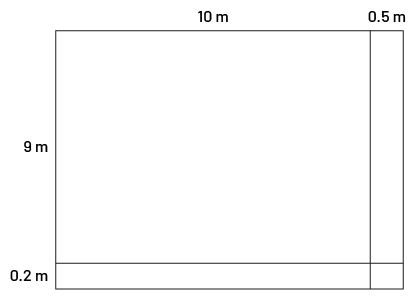B2.9 Multiply and divide decimal numbers by decimal numbers, in various contexts.
Activity 1: Looking for Patterns (Multiplication and Division of Decimal Numbers)
Materials
- grid paper (place value chart)
- calculator
Multiplying a decimal number by a decimal number
- Have each student construct a place value chart, including an initial number, like the one below.
Initial number: 5.6
| Number | Thousands | Hundreds | Tens | Ones | Tenths | Hundredths | Thousandths |
|---|---|---|---|---|---|---|---|
| \(5.6\; \times \;100\) | 5 | 6 | 0 | ||||
| \(5.6\; \times \;10\) | |||||||
| \(5.6\; \times \;1\) | |||||||
| \(5.6\; \times \;0.1\) | |||||||
| \(5.6\; \times \;0.01\) | 0. | 0 | 5 | 6 |
Divide the class into teams of two students. Each student will fill out the chart individually, and then analyze and compare it with their teammate. They note their observations and differences. Once all students have completed the task, review the chart as a group, noting student observations, comments and patterns.
Questions To Ask
- What do you notice about the number?
- Can you predict the result (without a calculator) of the following multiplication: 5.6 x 0.001? Explain your thinking.
Initial number: 4.2
| Number | Thousands | Hundreds | Tens | Ones | Tenths | Hundredths | Thousandths |
|---|---|---|---|---|---|---|---|
| \(4.2\; \times \;200\) | 8 | 4 | 0. | ||||
| \(\ 4.2 \times 20\) | |||||||
| \(4.2\; \times \;2\) | |||||||
| \(4.2\; \times \;0.2\) | |||||||
| \(4.2\; \times \;0.02\) | 0. | 0 | 8 | 4 |
Questions To Ask
- What do you notice about the number?
- Can you predict the result (without a calculator) of the following multiplication: \(4.2\; \times \;0.002\)? Explain your thinking.
- Give some multiplications to be calculated. Ask students to estimate the result and then do the work without using a calculator. Then ask students to compare their result with that of their teammate, and check the answers together using a calculator.
- \(3.0\; \times \;0.01\)
- \(5.6\; \times \;0.4\)
- \(1.8\; \times \;2.2\)
Division of a decimal number by a decimal number
- Do the same procedure with division
Initial number: 5.6
| Number | Thousands | Hundreds | Tens | Ones | Tenths | Hundredths | Thousandths |
|---|---|---|---|---|---|---|---|
| \(5.6\; \div \;100\) | 0. | 0 | 5 | 6 | |||
| \(5.6\; \div \;10\) | |||||||
| \(5.6\; \div \;1\) | |||||||
| \(5.6\; \div \;0.1\) | |||||||
| \(5.6\; \div \;0.01\) | 5 | 6 | 0. |
Begin a class discussion by comparing these results to those on the multiplication table.
Questions To Ask
- What do you notice about the number?
- Can you predict the result (without a calculator) of the following division: \(5.6\; \div \;0.001\)? Explain your thinking.
Initial number: 4.2
| Number | Thousands | Hundreds | Tens | Ones | Tenths | Hundredths | Thousandths |
|---|---|---|---|---|---|---|---|
| \(4.2\; \div \;200\) | 0. | 0 | 2 | 1 | |||
| \(4.2\; \div \;20\) | |||||||
| \(4.2\; \div \;2\) | |||||||
| \(4.2; \div \;0.2\) | |||||||
| \(4.2\; \div \;0.02\) | 2 | 1 | 0. |
Questions To Ask
- What do you notice about the number?
- Can you predict the result (without a calculator) of the following division: 4.2 ÷ 0.002? Explain your thinking.
- Give some divisions to be calculated. Ask students to estimate the result and then do the work without using a calculator. Then ask students to compare their results with that of their teammate and then check the answers together using a calculator.
- \(5.0\; \div \;0.01\)
- \(5.6\; \div \;0.2\)
- \(8.4\; \div \;1.4\)
Activity 2: Rectangles (Multiplication and Division of Decimal Numbers)
Materials
- grid paper
- whiteboard
Form teams of four students. Give them challenges to solve, such as the two examples below. Students should get used to using estimation to check if their answer is reasonable.
Review the solutions to the challenges as a class. Focus on strategies and understanding of operations.
Challenge 1
A rectangular lawn measures 10.5 m by 9.2 m. Clara subdivides her lawn in parts, as she wants to adjust the height of the mower to cut it according to the desired requirements.

- Estimate the total area, in square metres, of the lawn. Explain your strategy.
- Determine the exact area of the lawn in two different ways. Demonstrate and explain your strategies.
Challenge 2
For an agricultural fair, Chef Jacob has made a rectangular lasagna measuring 1.4 m by 1.2 m. He wants to serve pieces that are 7 cm by 6 cm.
- Estimate how many pieces the chef will serve. Explain your strategy.
- Explain or demonstrate how the chef will calculate the number of pieces he will be able to serve.
